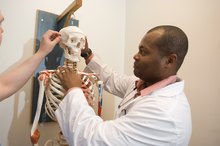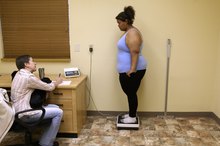Differences Between Masculine & Feminine Thighs
Women have more body fat than men, which means their limbs have a different shape. Women also have a different bone structure, particularly around their hips. This means male thighs and female thighs differ in size, shape and general structure, all of which are genetically determined and very difficult to change through your lifestyle.
Body Fat
Untrained women tend to have around 25 percent body fat, while untrained men tend to have around 15 percent body fat. Body fat is spread throughout the body, which means that on average, women have more fat on their thighs than men. This makes their thighs literally softer because their body fat gives women less muscle definition than most men have.
Muscle Mass
How Much More Muscle Mass Does a Male Have Than a Female?
Learn More
Masculine and feminine thighs are also different because of the male capacity to develop greater muscle mass. Men put on more muscle than women do. So, if a man and a woman have similar body fat, the man will still have larger thighs with clearer muscle definition because he is able to put on more muscle than his female counterpart. Even if the definition is the same due to the same amount of body fat, the man will still have physically larger thighs.
- Masculine and feminine thighs are also different because of the male capacity to develop greater muscle mass.
- So, if a man and a woman have similar body fat, the man will still have larger thighs with clearer muscle definition because he is able to put on more muscle than his female counterpart.
Size
Women deposit more fat around their thighs and buttocks than men do; women's bodies store fat in the thighs as a reserve for the energy needed for lactation. This means women have more fat in their thighs than men and therefore have bigger thighs in proportion to their body size.
Shape and Pelvis
Why Do I Still Have Cellulite if I Exercise?
Learn More
Men and women have different pelvis shapes. The pelvis, the bone that connects the upper body to the lower body, gives men and women their distinctive hip shape. In general, women tend to have wider hips due to a more circular pelvis. Wider hips mean a different thigh shape, as thighs are directly connected to hips. So, size, shape, fat and muscle aside, feminine thighs tend to have a different, more rounded shape than masculine thighs because of the outward flare of the hip bones.
- Men and women have different pelvis shapes.
- The pelvis, the bone that connects the upper body to the lower body, gives men and women their distinctive hip shape.
Related Articles
References
Writer Bio
Sam Grover began writing in 2005, also having worked as a behavior therapist and teacher. His work has appeared in New Zealand publications "Critic" and "Logic," where he covered political and educational issues. Grover graduated from the University of Otago with a Bachelor of Arts in history.









